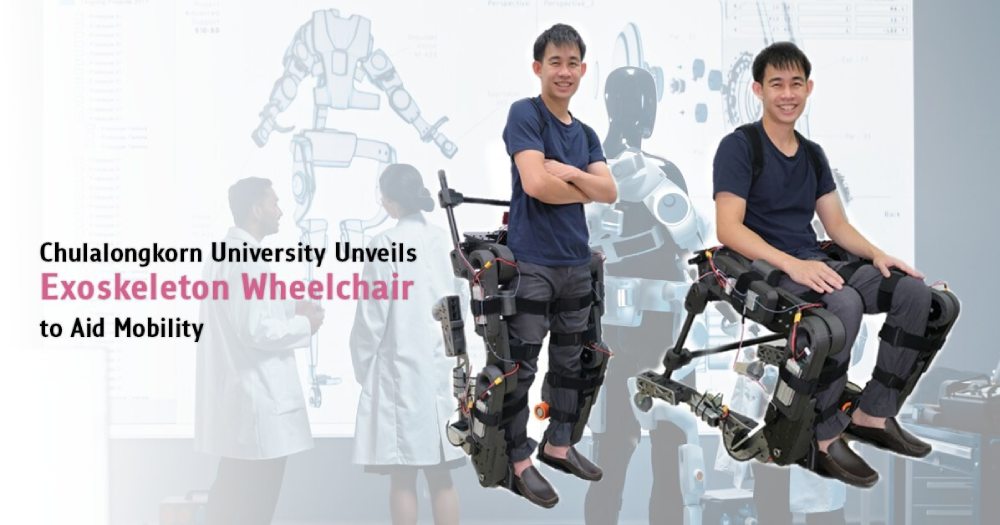Thailand’s Chulalongkorn University creates an Exoskeleton Wheelchair to help people sit, stand and walk

Chulalongkorn University is rewriting the rules of mobility with a groundbreaking invention: the Exoskeleton Wheelchair. Developed by Assoc. Prof. Dr. Ronnapee Chaichaowarat from the Faculty of Engineering, this robotic marvel merges the best of wheelchairs and wearable technology. Unlike traditional wheelchairs, which limit movement to flat surfaces, this innovation allows users to stand, walk, and tackle obstacles like stairs and public transport with newfound independence.
"I wanted to create a wheelchair that could walk," said Dr. Ronnapee. "An ordinary wheelchair can only move on a regular path, but it cannot get on the bus or go up and down the stairs. If a wheelchair could fold up and help the person sitting in it to get up and walk, it would make mobility much easier."
How does it work?
The Exoskeleton Wheelchair is no ordinary mobility aid — it's a hybrid system combining a wheelchair with an advanced robotic suit. Here's what makes it special:
- Wearable Robotics: The user wears the device like an exoskeleton, which supports movement while maintaining balance.
- Smart Mechanics: A motorized system controls the hip and knee joints, allowing users to transition smoothly between sitting and walking.
- Lightweight Design: Made from carbon fiber, the device is sturdy yet light enough for everyday use.
- Natural Motion: A flexible ankle joint ensures movement mimics natural human walking.
Dr. Ronnapee took a meticulous approach to biomechanics, ensuring the device moves in harmony with the user's body. "The exoskeleton must not overstretch or shrink too much, nor should it cause skin irritation. Every time the legs swing, so should the exoskeleton. When the knees bend, the robot's knees must bend at the same time," he explained.
Why does it matter?
This innovation isn't just a cool piece of tech — it's a game-changer for people with mobility challenges. It addresses a few key challenges, including:
- More Freedom: Users can navigate spaces previously off-limits, such as staircases and public transport.
- Aging Population: As Thailand's elderly population grows, demand for wearable robotic aids is expected to rise.
- Medical Advancements: The device could transform rehabilitation for patients recovering from strokes or injuries.
- Global Recognition: This is the first exoskeleton wheelchair developed in Thailand, positioning the country as a player in cutting-edge robotics.
"At the Faculty of Medicine, there are already patients who want to participate in the trial, but we have not put it to the test yet because the robot still needs adjustments," Dr. Ronnapee noted. "Once it passes the Research Ethics Committee's approval, we will accelerate production."
The context
Chulalongkorn University's robotics lab, housed on the 9th floor of the Chulapat-14 Building, is the birthplace of this pioneering invention. The lab serves as a melting pot for students and researchers from around the world, all driven by a common goal: pushing the boundaries of robotics.
The Exoskeleton Wheelchair project first took off with funding from Thailand's National Research Council (NRCT) between 2021 and 2022. By 2024, it had earned recognition as a finalist in the prestigious Young Technologists Award.
But the journey is far from over. The prototype, which currently costs 130,000 baht (around $3,900), is being refined for better stability and usability. Clinical trials are on the horizon, and if successful - this Thai-made marvel could redefine mobility assistance worldwide. Pretty cool.
💡Did you know?
You can take your DHArab experience to the next level with our Premium Membership.👉 Click here to learn more
🛠️Featured tool
 Easy-Peasy
Easy-Peasy
An all-in-one AI tool offering the ability to build no-code AI Bots, create articles & social media posts, convert text into natural speech in 40+ languages, create and edit images, generate videos, and more.
👉 Click here to learn more


